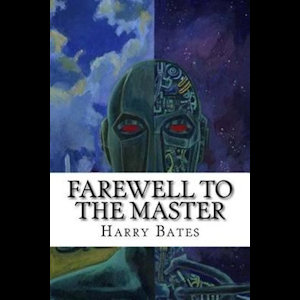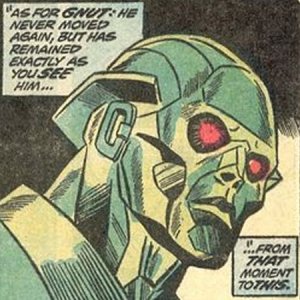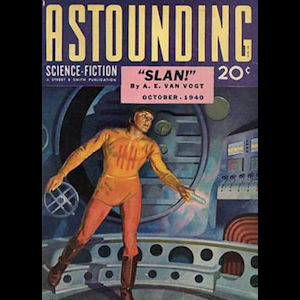"Farewell to the Master" by Harry Bates - Sci-Fi Classic Review
 | | Farewell to the Master |
As one of many notable science-fiction magazine editors from the first half of the Twentieth Century, Harry Bates isn't as controversial or influential as the likes of John Campbell or Hugo Gernsback, but he was a heavy hitter in his day. Born Hiram Gilmore Bates III, Harry worked for several pulp magazines, culminating in a three-year run as head of Astounding Science-Fiction, though he is best known for writing the subject of today's examination: 1940's "Farewell to the Master," the short story that inspired The Day the Earth Stood Still. Interestingly enough, Bates wasn't a big fan of science-fiction, professing it to be little more than puerile fantasy (at least, as it was written in those days). His largest writing project, the Hawk Carse series, was widely panned for being a badly written, cliché space opera, so I would take his opinion of the genre with a hefty dose of skepticism.
To be sure, even "Farewell to the Master" lacks much in the way of actual science. Unlike the Hawk Carse stories, though, it is well-written, imaginative, and innovative for its time. It takes a sci-fi concept that was already well-worn by 1940--the alien invasion--and tries to subvert expectations in order to make a point about the pitfalls of assumption. The story is told a little unconventionally, with the first third containing an extended bit of expositional history and with a protagonist that is neither particularly heroic nor morally compromised. Above all, it is the motives of the two sole "invaders" that departs from tradition, in that they appear to be benevolent, though their true motives are never explained.
They emerge from a small vessel that appears without fanfare--it doesn't land from above; it merely pops into existence--on the Capital lawn (where hundreds of subsequent alien visitation stories would also take place). One, named Klaatu, appears wholly human, though he is described in highly idealized terms as "godlike," and the other is a silent, green, eight-foot robot named Gnut (not Gort). Greeting the assembled masses with a gesture of peace, Klaatu only gets out seven words of greeting before a lunatic shoots him dead, and after that, three months of uncertainty pass with the robot remaining utterly still. Klaatu is interred in a mauseleum, while a wing of an adjacent museum is built around Gnut and the alien vessel. Various tests are performed that only serve to prove that Gnut and the vessel are completely impervious to mankind's meager probes and tools of destruction.
 | | Marvel released a comic adaptation in 1973 |
Enter Cliff Sutherland, a photojournalist who has made a career out of snapping pictures of Gnut from every conceivable angle and in every possible light. One day, he happens to notice that Gnut has moved ever so slightly, so Sutherland hides in the museum in order to spend the night alone with the robot. What follows is a strange and terrifying night in which Gnut releases a gorilla from the vessel and fights it to the death. Cursing himself for not getting any good photos of the experience, Sutherland stays another night with Gnut and witnesses something even more chilling: Sitwell, a man Sutherland knows, emerges from the vessel, confused and panicked, before dying abruptly. Gnut then takes from the vessel a second human body, which appears to be an identical copy of the dead Sitwell.
When day breaks, Sutherland sells his story and maneuvers himself into exclusive access to the government's next move, which is to attempt to seal Gnut in "glasstex," a highly advanced, transparent polymer. After night falls, Gnut breaks free from his prison of plastic, breaks out of the museum, withstands a few potshots from a frightened military, kidnaps Sutherland, and runs over to the tidal basin where Klaatu's body is held. The robot takes the alien back to the vessel and Sutherland stows away long enough to witness the alien's resurrection using a bizarre technology capable of rebuilding Klaatu using nothing but the sound of his recorded voice. The recreation is imperfect, and the new Klaatu only lives long enough to explain to Sutherland that Klaatu has been experimenting, using recordings from the museum to create the things Sutherland has witnessed, including the gorilla and Sitwell (the real version of whom was previously revealed to be still alive).
The next day, Sutherland gives Gnut the recording device that captured Klaatu's voice in the hopes that Gnut can reverse engineer the flaws of the recording and make a more stable copy of his master. Gnut thanks him and, before returning to his vessel and leaving Earth behind once and for all, tells Sutherland that he was wrong about one thing: Gnut, not Klaatu, is the master.
 | | This is the issue in which "Farewell to the Master" was first published |
There's a lot of ambiguity in this story. I have a personal favorite way of interpreting it, plot-wise, that involves a future robot revolution and time travel and other silliness like that, but the ambiguity is a deliberate choice by Bates to demonstrate how little we truly understand when we let out preconceptions control our thinking. There is no right or wrong way to assume what Gnut and Klaatu are, because we aren't given enough data. Instead, we are shown how even the use of one simple (albeit fantastic) technology can create seemingly inexplicable events like a gorilla appearing in a museum or the creation of multiple copies of a man living miles away. Therefore, trying to assume where the alien vessel came from and what Klaatu and Gnut's purposes are is a fool's errand. Even assuming that the humanoid controls the robot is revealed to be wrong in the story's final twist.
Other than that, there's honestly not much to "Farewell to the Master." With enough academic overanalysis, one could make a thesis out of Bates' use of technology (do we control it or does it control us, etc.), but I don't think Bates was trying to do much more than write a neat story that urges readers to avoid hasty generalizations. If that was his aim, he succeeded, and on its own, "Farewell to the Master" is a pretty good short story that takes less than an hour to breeze through. I could bicker with Bates about whether it is enough of a departure from the puerile fantasy he so derided from the genre, but even if Bates' views on the matter are hypocritical and self-defeating, he still wrote something I'd proudly recommend.
Of course, that's not this story's sole legacy. A decade after the story's publication, in a newly post-atomic world, its simple premise would be expanded wildly into a science-fiction classic that bears little more than a cosmetic resemblance to Bates' vision. In the next installment, we dive into 1951's The Day the Earth Stood Still and discuss why it is such an endlessly cherished piece of sci-fi cinema.
-e. magill 1/10/2019
|
|